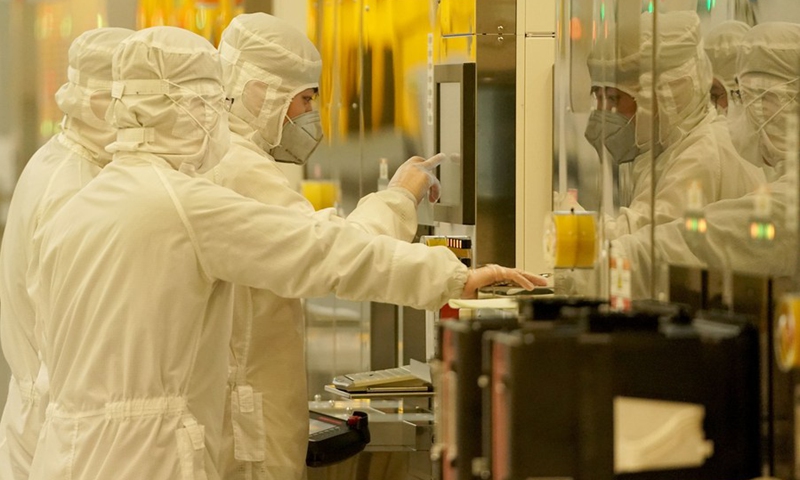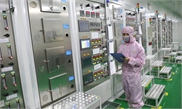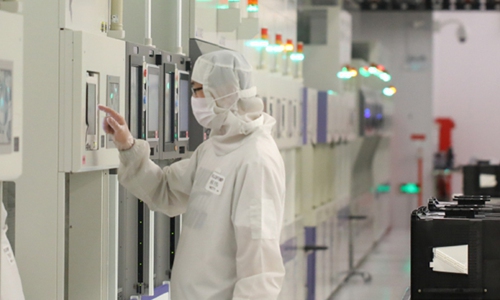SOURCE / INDUSTRIES
US-Taiwan semiconductor deal a political show: experts

Technicians work in a workshop of Wuhan Xinxin Semiconductor Manufacturing Co., Ltd (XMC) in Wuhan Donghu New Technological Development Zone in Wuhan, capital of central China's Hubei Province, Feb. 14, 2020. (Photo: Xinhua)
Taiwanese authorities is putting their key supply chains at risk by following the US government blindly in trying to set up a unilateral one-way route of supply chain, which serves the US' ill intention to contain the Chinese mainland, the world's largest and fastest- growing electronics market.
The remarks came after a so-called partnership between US and Taiwan authorities for economic prosperity dialogue was launched on Friday. The Taiwan economic and cultural representative office in the US and the American Institute in Taiwan on Friday signed a memorandum of understanding in areas such as cooperation on science and technology, 5G and telecommunications security, and the supply chains, Reuters reported on Saturday.
TSMC will set up a factory in the US to deepen semiconductor cooperation between the two parties, Reuter reported, citing Wang Mei-hua, head of Taiwan's economic affairs authority.
Experts said any attempt to hit the mainland's electronics industry by moving the supply chains out of the Chinese mainland is not feasible and will be futile, and is difficult to realize, experts said.
The US authorities have sought to promote cooperation in the semiconductor sector to strengthen its competitiveness and hit high-tech industry in Chinese mainland. The US is using various means to force the restructuring of the global semiconductor industry chain, trying to rally its allies to establish a de-centralized industry chain, Xie Nan, associate researcher with the Chinese Academy of Social Sciences, told the Global Times.
"The world's biggest market for semiconductors is the Chinese mainland, and if the semiconductors are concentrated in the US and the island of Taiwan, there is a question mark over whether they are capable of producing and consuming enough terminal products," Xiang Ligang, director-general of the Beijing-based Information Consumption Alliance, told the Global Times on Sunday.
"After all, US consumption of semiconductor equipment remains relatively small, and ultimately the producers will have to serve the Chinese mainland market," Xiang said.
In the third quarter, the mainland was the world's largest semiconductor market, despite the pandemic. The mainland contributed 30 percent of global semiconductor revenue, compared with Taiwan's 23 percent and South Korea's 20 percent, according to data from the top six semiconductor equipment companies.
TSMC's plants in the US account for only 3 percent of TSMC's output. Moreover, Foxconn's plan to build a factory in the US under the urging of US President Donald Trump has stalled, Xiang said, adding that higher labor costs and a weaker industry chain are major causes for the failure.
"Besides, TSMC is a manufacturer of integrated circuits and wafers for companies like Huawei and Apple, and global mobile phone manufacturing bases are located in Asia, especially Chinese mainland," said Xiang. By moving to the US, TSMC will be far away from the demand market, and transport costs will increase significantly.
That the US chose to work with Taiwan for its unilateral plan for the supply chain is within expectations, since the US is losing its competitive advantage in manufacturing and trade to Chinese mainland, Hong Shibin, an analyst of manufacturing supply chains, told the Global Times.
"The US has become very passive and increasingly isolated now, and currently what the Trump administration can think of is trying to technologically block China," said Hong.
In the face of the blatant US squeeze of Chinese mainland technology companies, Beijing has stepped up efforts to accelerate semiconductors research and development, with unprecedented investment expected to be made.


